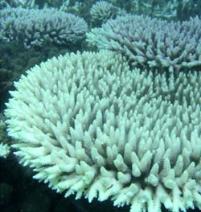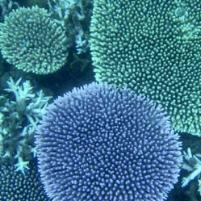Coral observers tip mass bleaching of Keppel region
Published on 16 January, 2006
Central Queensland University's coral observers are tipping a possible mass bleaching of the Keppel region for the first time since 2002.
The Keppel region has some of the best fringing inshore coral reef in the central Great Barrier Reef, with over 80% hard coral cover.
But CQU researcher Alison Jones said water temperatures were between 1 and 1.5 degrees higher than the long term January averages.
 “Evidence from previous summers, where climate conditions were similar to these, suggests that there is potential for sea temperatures to continue to increase over coming weeks. However, the actual risk of stressful conditions depends on a complex interaction of regional water temperatures, local air temperatures, cloud cover, winds and rainfall,” she said.
“Evidence from previous summers, where climate conditions were similar to these, suggests that there is potential for sea temperatures to continue to increase over coming weeks. However, the actual risk of stressful conditions depends on a complex interaction of regional water temperatures, local air temperatures, cloud cover, winds and rainfall,” she said.
"We have had temperatures of 29 degrees and over for a month or more since late December and this has pushed the corals at Keppel over their tolerance.”.
Ms Jones said the corals were at their prettiest now as they 'fluoresce'.
"The zooxanthellae are a green brown colour and as they are jettisoned by the coral, the coloured pigments in the coral become more obvious and there are pinks, blues, purples and greens.
"Eventually all the colour will go. At that stage the coral polyp is still alive and can survive for some time if temperatures stabilise, but after about 3 months without their symbiotic partners to provide nutrient they will die and be covered with algae.
"The last bleaching event here was in 2002 and we had over 98% bleaching of live hard coral cover, but 100% recovery due to the types of coral here and their algal partners.
 "The Keppels are quite unique as one of the main reef building corals 'Acropora millepora' seen in the photos harbours two types of algae or zooxanthellae and one of those - the D type - is more tolerant of high temperatures.
"The Keppels are quite unique as one of the main reef building corals 'Acropora millepora' seen in the photos harbours two types of algae or zooxanthellae and one of those - the D type - is more tolerant of high temperatures.
"After the 2002 bleaching episode, there was a higher percentage of Acropora millepora with the D type zooxanthellae and we would expect this to happen again." .
Ms Jones said she was accompanied on the latest trip to the Keppels by CQU research assistant Leica Briskey as well as helpers John Dooley and Karen Christie.
For details call Alison on 07 4930 9945 or Mobile 0408 068 128.
High resolution photos from the coral sampling trip are available via the website.
http://www.cquimages.cqu.edu.au/index.php?urlCourseID=20

